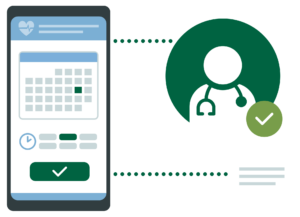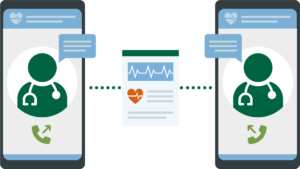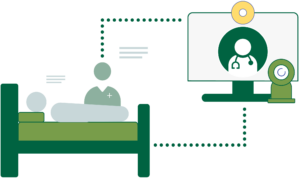Patient access
New technology brings more access to care
Patient access
New technology brings more access to care
Marie Sandoval, MD, has seen many routine patient visits unearth a serious health concern requiring follow-up care and specialist expertise. Such was the case in late November 2023, when Jack Galt, a long-time patient walked in for his annual visit. He mentioned feeling pain in his chest while riding his bike.
To investigate, Dr. Sandoval conducted tests of Galt’s heart and, concerned by the results, needed the insight of a cardiologist.
In the past, Dr. Sandoval would have needed to refer Galt for an in-person cardiology appointment, have him schedule that appointment, and then wait until it arrived to find out what was wrong and what could be done about it. But instead, Dr. Sandoval submitted an eConsult – a rapid, digital consultation between primary care and specialist providers.
In less than 24 hours, she received detailed guidance from cardiologist Kevin Carey, MD. Not long ago, this process may have taken several weeks, or more. Instead, Galt and his family received the clarity they needed in less than a week.
The eConsult bypassed a lot of back and forth and got me a wealth of information really quickly. I found out that I had blockages in the arteries around my heart, which was causing the pain. I’ve been going to cardiac rehabilitation since then, which has been a fantastic experience
Jack Galt
By cutting down on clinically unnecessary appointments and keeping more care in primary care offices, eConsults are freeing up specialists for more in-person appointments. The eConsults program has led to an 11% increase in available in-person appointments at some specialties across the health system.
Growth and impact of the econsults program
specialties offer eConsults, including endocrinology, cardiology, pulmonology and rheumatology
eConsults ordered in 2023, the first year of its use
estimated eConsults for 2024, with a goal of 4,000
eConsults ordered in May 2024, the single highest usage within one month

Within the coming months, self-scheduling options will allow patients to find and schedule their own appointments with their primary care provider, an option that will be expanded in the future to include specialist visits as well.
And, as of June 12, 2024, we launched Fast Pass, which offers unused appointment slots to patients via a MyChart message. In just the first few weeks from launch, we had nearly 190 “offers” accepted by patients, resulting in an average improvement of appointment times by 49 days for family medicine and 43 days for general internal medicine.

Telemedicine systems at each of our six hospitals, and other community and regional hospitals, connect providers with specialist expertise during emergencies, such as a person experiencing a stroke or a newborn baby who requires intensive medical care or transportation.

Telestroke give people experiencing a stroke a better chance of making a full recovery by quickly connecting them with neurology specialists, even if they are based at another location.
Providers have used telestroke nearly 500 times since 2021, and a growing number of hospitals outside of UVM Health Network are also benefitting from the expert care available through the program.

Our new system cuts back on duplicate imaging procedures, like MRIs or CT scans, helping reduce costs for patients and making it easier for them to access the care they need by preventing scheduling logjams.
Taken together, all of these [technology-enabled] initiatives will make it much easier and more convenient for people to get the care they need.
Todd Young, associate vice president of digital health services at UVM Health Network artificial intelligence in certain care settings
When you’re in pain, waiting for a surgical appointment can feel like an eternity. Such was the case for Susan Anderson, who needed both of her hips replaced last year. “I wanted to go to UVM Medical Center for the procedures, but unfortunately the wait was just too long,” says Anderson.
Read more about our work to increase local surgical care options
While timely appointments are important, many people struggle to get high-quality care due to health care costs and other personal challenges, such as a lack of reliable transportation, access to healthy food and more.
Read more about our programs to help people overcome barriers to health care